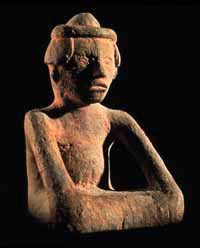
Prehistoric Native American Lesson Plan: Mississippian Regalia
Illinois State museum Web sites used:
Museumlink Prehistoric Native American module https://
www.museum.state.il.us/muslink/nat_amer/pre/index.html
Falcon Dancer Exhibit in Behind the Scenes module. https://
www.museum.state.il.us/muslink/behind/htmls/exh_fal.html
Objective: After reviewing the Prehistoric Native American Web site
section on the Mississippian culture and doing this activity, students
will be able to describe how objects such as body ornaments and clothing reflect a culture, a time, and a
way of life as seen in the pattern, design, and materials.
Time required: one class period
Grade Levels: 3-6
Materials:
Web site mentioned above
worksheet
drawings of Mississippian figure and descriptive page of ornaments
pencil
colored pencils
Procedure:
Have students read about the Mississippian culture. Discuss how the culture and time period has a
specific style, uses specific materials, and uses objects in particular ways. Go over the worksheets on
regalia (defined as that belonging to royalty), noticing what materials were used and how these objects
were worn or used. Ask about the regalia people use today to distinguish themselves in a particular role
or status in society.
Explain that we know what ornaments Mississippian people of importance wore based on archaeologi-
cal finds such as gorgets and copper pieces that are engraved with dressed figures. Very few cloth or fur
fibers have been found because they deteriorate over time.(see the Falcon Dancer exhibit section of
Behind the Scenes Web module),
Directions: the left-hand column shows a line drawing of the ornament. The center column text de-
scribes the object, its material, and its use. The right-hand column shows how the ornament was worn.
Prehistoric Native American Activity: Regalia --page 1 of 4
On the image of the figure, draw each ornament in its correct position. Next, color the resulting picture
according to the materials that were used. Remember Native Americans of this period (750 - 1450 A.D.)
used materials in their natural colors or dyed them with natural dyes (brown, yellow, red) from plants.
(see Falcon Dancer online exhibit and Dye Plant activity for more information).
Assessment: After viewing the Mississippian section of the Prehistoric Native American Web module
and completing this activity, students will explain what materials and regalia objects important Missis-
sippian individuals wore and how we know about them.
Resources:
"Mississippian Society Exhibit" Dickson Mounds Museum, Lewistown, Illinois.
Johnson, Judy. Traditional Clothing of the Indians of Illinois: Pre-European Influence, ca. A.D. 1675.
American Indian Pamphlet Series No. 8, Illinois State Museum, Springfield, Illinois.
Illinois Goals and Standards addressed:
Visual Art: Goal 27: Understand the role of the arts in civilizations, past and present.
Standard B: Understand how the arts shape and reflect history, society, and everyday life.
Social Studies: Goal 18: Understand social systems (U.S.)
Standard A: Compare characteristics of culture as reflected in the arts and traditions.
Prehistoric Native American Activity: Regalia --page 2 of 4
Mississippian Regalia Artifact Information
These drawings represent the type of ornaments that important Mississippians would have worn 1,000
years ago. Archaeologists found artifacts made of copper and shell similar to these objects at various
Mississippian sites.
Read the description of each object. Note where on the body it was worn. On the following image of the
Falcon Dancer, draw in each ornament as it would have appeared. Color it according to the information
you found here and in the Falcon Dancer online exhibit.
Falcon Headdress
This copper headdress was worn sideways on the forehead.
The fierce peregrine falcon was a symbol of the warriors,
who were often led by the chief or his brother. Many war-
riors painted or tattooed an eye design similar to the mark-
ings on a falcon's eye.
Bilobed (having two round parts) Arrow
This mostly copper ornament was inserted into the hair,
which was wrapped into a bun at the back of the head.
Earspools
Earspools were made of copper, stone, or copper-covered
wood and were inserted into slits made in the ear lobes.
Gorget
A gorget is a pendant with two holes through which a cord
was strung. It was worn as a necklace. This design was
found on a copper gorget at Dickson Mounds.
Marine Shell Pendant
Shells from the Atlantic Ocean and Gulf of Mexico were
traded to the Dickson Mounds area and even farther north.
Shells were hung as pendants from a cord or strand of shell
beads and worn as a necklace.
Beads
Beads made of marine shell, bone, or freshwater pearls
were worn as necklaces, anklets, bracelets, or just below the
knees, in the hair, or were sewn onto clothing.
Conch Shell Cup
Conch shells engraved with elaborate designs and used to
serve special drinks at ceremonies.
graphics
column
graphic
column
Prehistoric Native American Activity: Regalia --page 3 of 4
scan figure drawing here
Falcon Dancer
Prehistoric Native American Activity: Regalia --page 4 of 4
